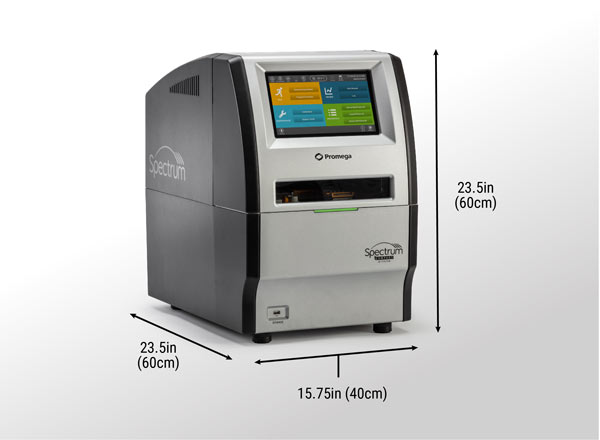Capillary Electrophoresis (CE) Instruments
Spectrum and Spectrum Compact CE Systems provide scalable solutions for DNA fragment analysis for forensic labs, and for cell line and mixed sample analysis for research labs. Spectrum Compact is also designed for Sanger sequencing analysis, supporting NGS and CRISPR-cas9 confirmation.
Spectrum CE Systems Comparison
| Spectrum CE | Spectrum Compact CE | |
|---|---|---|
| Overview | High throughput capacity CE system ideal for medium and large labs handling many samples | Benchtop CE system ideal for smaller labs looking to increase efficiency |
| Applications | Fragment Analysis | Sanger Sequencing, Fragment Analysis |
| Number of capillaries | 8 (24 coming soon) | 4 |
| Capillary array length | 36cm | 36cm |
| Maximum number of dye colors | 8 | 8 |
| Throughput | High Throughput Four 96-well plates with continuous access |
Low–Medium Throughput Four 8-well strip tubes |
| Computer platform | Separate computer and monitor | Integrated touch screen with built-in computer |
| Polymer | Polymer4 | Polymer4 and Polymer7 |
| Consumables Tracking | RFID | 2D barcode |
| Data File Type | .fsa and .promega | .fsa and .ab1 |
| Secondary analysis | GeneMarker®HID Software for Spectrum CE Systems | GeneMarker®HID Software for Spectrum CE Systems, ProView® Sequencing Software |
| Weight | 103kg (228lb) | 45kg (99lb) |
| Dimensions | 68cm W x 68cm D x 77cm H | 40cm W x 60cm D x 60cm H |

|

|
An Introduction to Capillary Electrophoresis
Capillary electrophoresis is a method for separating and identifying fragments of fluorescently-labeled DNA by passing them through very thin polymer-filled capillaries. The use of capillaries instead of a conventional slab gel makes it possible to apply a much stronger electric field, resulting in faster separation and higher throughput. The process features single-base resolution and requires small sample quantities.
Fluorescently labeled DNA samples are prepared for electrophoresis and loaded into the CE instrument. The capillary array is filled with polymer and placed into the sample wells. When the capillary array enters the wells, an electric current is formed, and the DNA fragments are moved electrokinetically into the capillaries. Next, the ends of the capillary array are inserted into the cathode and anode buffer. The instrument applies a specific voltage and temperature to control sample migration through the capillary array. The fragments are separated by size, with the smallest fragments moving fastest.
The final step is sample detection. As the fluorescently labeled fragments move past the detection window, a laser excites the fluorescent dyes. The emitted light is spectrally separated and recorded by a CCD camera. The CCD camera records the fluorescent signature of each fragment, as well as the elapsed time for the fragment to migrate through the polymer. The raw data is sent to the collection software in the form of a peak and is now ready for analysis.
Applications include STR analysis and Sanger Sequencing, as well as many other everyday functions of both forensic, academic and clinical research laboratories.





